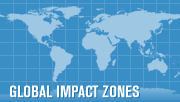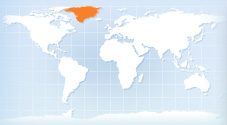Melting Glaciers Threaten to Raise Global Sea Levels Over 20 Feet

Massive Iceberg Broke Off Greenland
In August of 2010, an iceberg covering nearly 100 square miles – four times the size of Manhattan – calved from the Petermann Glacier on the northwestern coast of Greenland. The iceberg is the largest to break off in the Arctic in nearly a half century, sounding a warning bell that global warming pollution must be cut to avoid catastrophic loss of ice on Greenland, at the poles, and from glaciers around the world.
Melting Ice Sheet Threatens to Raise Global Sea Levels Over 20 feet
Greenland is almost entirely covered by a massive ice sheet that is roughly the size of Mexico (700,000 square miles) and is up to two miles thick. The Greenland ice sheet contains nearly a tenth of the world's fresh water supply. If this ice sheet were to melt completely, sea level would rise by more than 20 feet, presenting dire consequences to coastal regions around the world. Even a 3-foot increase in sea level, which could well be exceeded by the end of the 21st century, threatens tens of millions of people living in coastal zones around the world.
Greenland ice sheet: Slip sliding away?
The rapid changes seen in Greenland suggest we are dangerously close to a climatic tipping point. In fact, at a Select Committee briefing in August of 2010, a leading climate scientist indicated that we could even have already passed a tipping point in the Arctic. During a visit to Dr. Konrad Steffen’s research station on the Greenland ice sheet, Select Committee Members learned about the mounting scientific evidence which makes clear that global warming is causing an alarming acceleration in the rate of melting of the Greenland ice sheet.
Temperature trends are up across Greenland and are strongest in the north. Since 1950, for example, northern Greenland has experienced warming of 2.7 – 3.6 degrees Fahrenheit. As Greenland warms, the amount of ice flowing into the sea from the ice sheet is outpacing the buildup of snow further inland.
Measurements show that the region of ice loss is spreading up the northwest coast of Greenland. Scientists have estimated that the total loss of ice from Greenland between 2000 and 2008 was approximately 1,500 gigatons, which is enough to raise global sea level nearly a half millimeter per year. Also, the rate of ice loss has been accelerating, meaning the contribution to global sea level will continue to grow with time.
Melting at the surface threatens the overall integrity of the ice sheet by causing lakes to form on the ice sheet’s surface. The meltwater then percolates downwards through massive cracks in the ice sheet called “moulins,” lubricating the base of the ice sheet and hastening the slide of glaciers toward the sea. Observations indicate that the melting rate can be particularly high along glacier margins, where ice comes into contact with warm ocean waters. Scientists have also observed an alarming increase in “ice quakes” due to glacial movement—measuring up to 5.0 on the Richter scale—raising questions about the ice sheet’s stability. These trends indicate that the accelerating melting of Greenland’s ice sheet increases the risk of dangerous sea-level rise sooner than previously predicted.
On a local scale, global warming is already having negative impacts on the livelihoods of Greenland's indigenous Inuit population. The loss of stable, year-round sea ice is disrupting traditional seal-hunting and fishing practices on which Inuit livelihoods depend. As in other parts of the Arctic, melting of permafrost is causing extensive damage to homes and other infrastructure in Inuit villages. During the Select Committee's trip to Greenland, the Greenland Premier Hans Enoksen, national and local leaders, and residents all emphasized that changes to their environment are rapid and have far reaching economic and cultural impacts.



